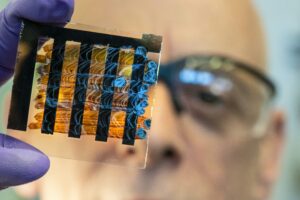
In a groundbreaking experiment, physicists have successfully measured the pulse of an atom’s magnetic heart as it oscillates between quantum states. This remarkable achievement was realized in a laboratory setting using a scanning tunneling microscope, which allowed researchers to observe the synchronized movement of electrons and the nucleus of a titanium-49 atom. This observation enabled them to estimate the duration of the atom’s core magnetic beat in isolation.
“These findings,” the researchers noted in their paper, “provide atomic-scale insight into the nature of nuclear spin relaxation and are pertinent for the development of atomically assembled qubit platforms.”
Understanding the Spin: A Quantum Perspective
In the realm of quantum physics, “spin” is a term used to describe a quantum version of angular momentum. This concept is not only fundamental to the behavior of magnets but also forms the basis of quantum computing, where it acts as a ‘bit’ of information known as a qubit. The collective spins of numerous subatomic particles contribute to a nucleus’s overall spin. However, this state can be easily influenced by the atom’s environment.
Understanding the characteristics of this collective spin state before environmental interference could provide engineers with a new type of qubit to utilize. Observing the spin state of a nucleus without affecting it presents a significant challenge, prompting a team led by physicists Evert Stolte and Jinwon Lee from the Delft University of Technology in the Netherlands to explore alternative methods.
The Role of Hyperfine Interaction
Several years ago, researchers discovered they could use the hyperfine interaction between electrons and their nucleus as a guide, circumventing the need to directly interfere with its magnetic dance. “The general idea had been demonstrated a few years ago, making use of the so-called hyperfine interaction between electron and nuclear spins,” explains physicist Sander Otte of the Delft University of Technology. “However, these early measurements were too slow to capture the motion of the nuclear spin over time.”
To address this, the researchers developed a pulsed measurement scheme. This technique involves using a scanning tunneling microscope to measure an atom with a known nuclear spin in short pulses, with breaks in between, rather than a continuous measurement.
Experimenting with Titanium-49
The team selected titanium-49, a stable, naturally occurring isotope, for their experiment. This isotope is favored in nuclear physics research due to its intriguing magnetic-reactive properties and strong spin, which scientists can manipulate to better understand atomic nuclei behavior.
Under their pulsed regime, Stolte and Lee observed the atom’s switching in real-time on their computer screen. They determined a time interval of about five seconds between each switch, a measurement that was faster than the nucleus’s oscillation. “We were able to show that this switching corresponds to the nuclear spin flipping from one quantum state to another, and back again,” Stolte stated. “The first step in any new experimental frontier is being able to measure it, and that is what we were able to do for nuclear spins at the atomic scale.”
Implications for Quantum Computing and Beyond
This development represents a significant leap forward in the field of quantum computing and atomic-scale physics. By gaining a deeper understanding of nuclear spin dynamics, researchers can potentially develop more efficient qubit platforms. This could lead to advancements in quantum computing, offering faster and more reliable processing capabilities.
Looking ahead, the ability to measure and manipulate nuclear spins at the atomic scale could open new avenues for research and technology development. As scientists continue to explore the quantum realm, the insights gained from such experiments could pave the way for innovations in various fields, from computing to materials science.
The research conducted by Stolte, Lee, and their team highlights the intricate dance of particles at the atomic level, offering a glimpse into the fundamental processes that govern the universe. As they continue to push the boundaries of what is possible, the scientific community eagerly anticipates the next breakthroughs that will emerge from this cutting-edge research.





